Entrepreneurship: Impact of Small Business Management on Economy
VerifiedAdded on 2023/01/12
|19
|4556
|84
Report
AI Summary
This report provides a comprehensive analysis of entrepreneurship and small business management, exploring various types of entrepreneurial ventures such as large company, scalable, small business, and social ventures, and their relationship to different typologies like aggressive growth, lifestyle, managed growth, and survival ventures. It examines the similarities and differences between these ventures, focusing on their aims, innovation approaches, and hiring processes. The report further investigates the impact of small and micro businesses on the UK economy, supported by data and statistics, highlighting their contributions to GDP, employment, and tax revenues. It also determines the significance of small businesses and startups to the growth of the social economy, emphasizing their role in local, regional, and national economic development. Additionally, the report discusses the attributes and skills necessary for entrepreneurs, analyzing how entrepreneurial personalities reflect motivation and mindset, and concludes by assessing the effect of background and experience on entrepreneurship. Desklib offers this report along with a wide range of study resources for students.
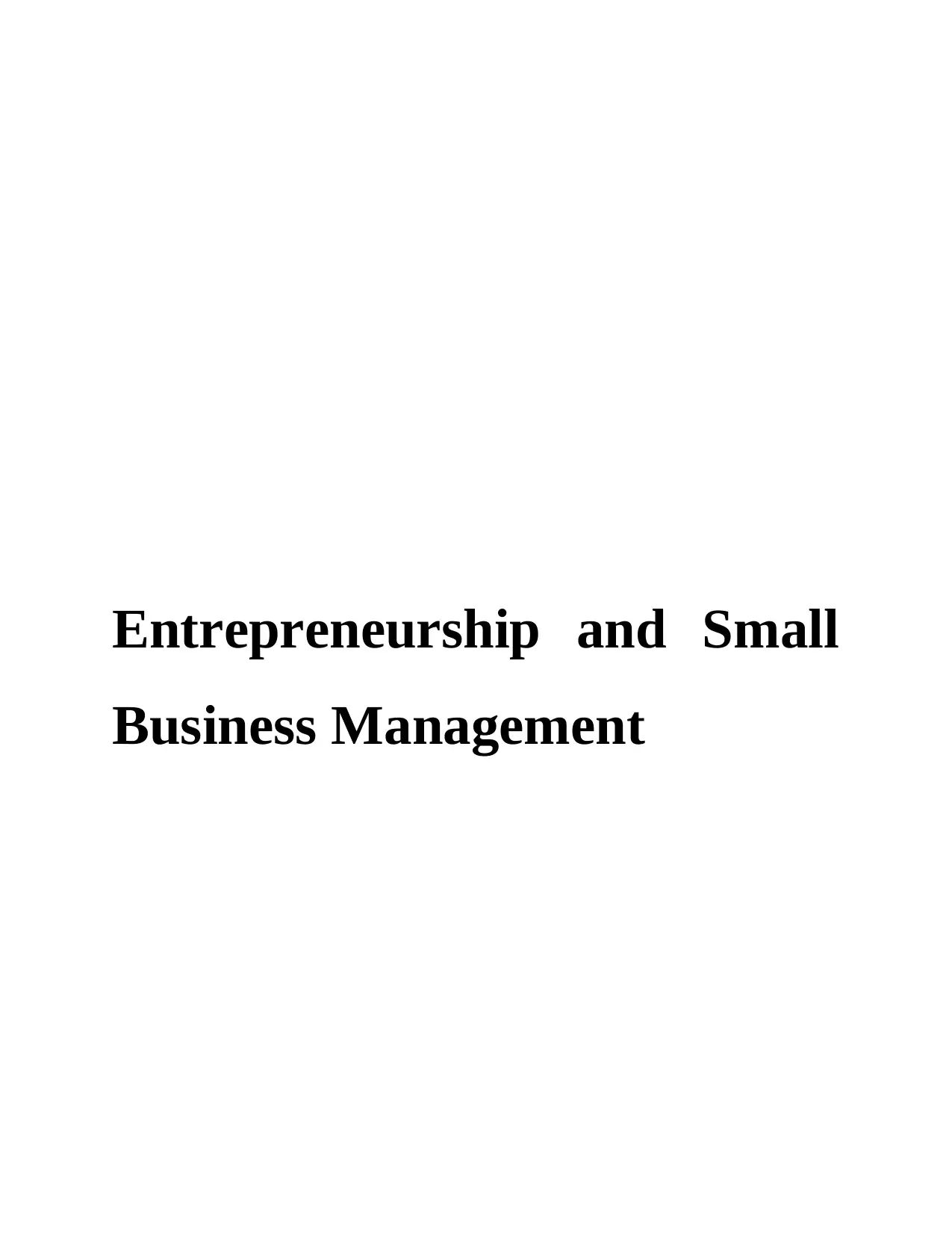
Entrepreneurship and Small
Business Management
Business Management
Paraphrase This Document
Need a fresh take? Get an instant paraphrase of this document with our AI Paraphraser
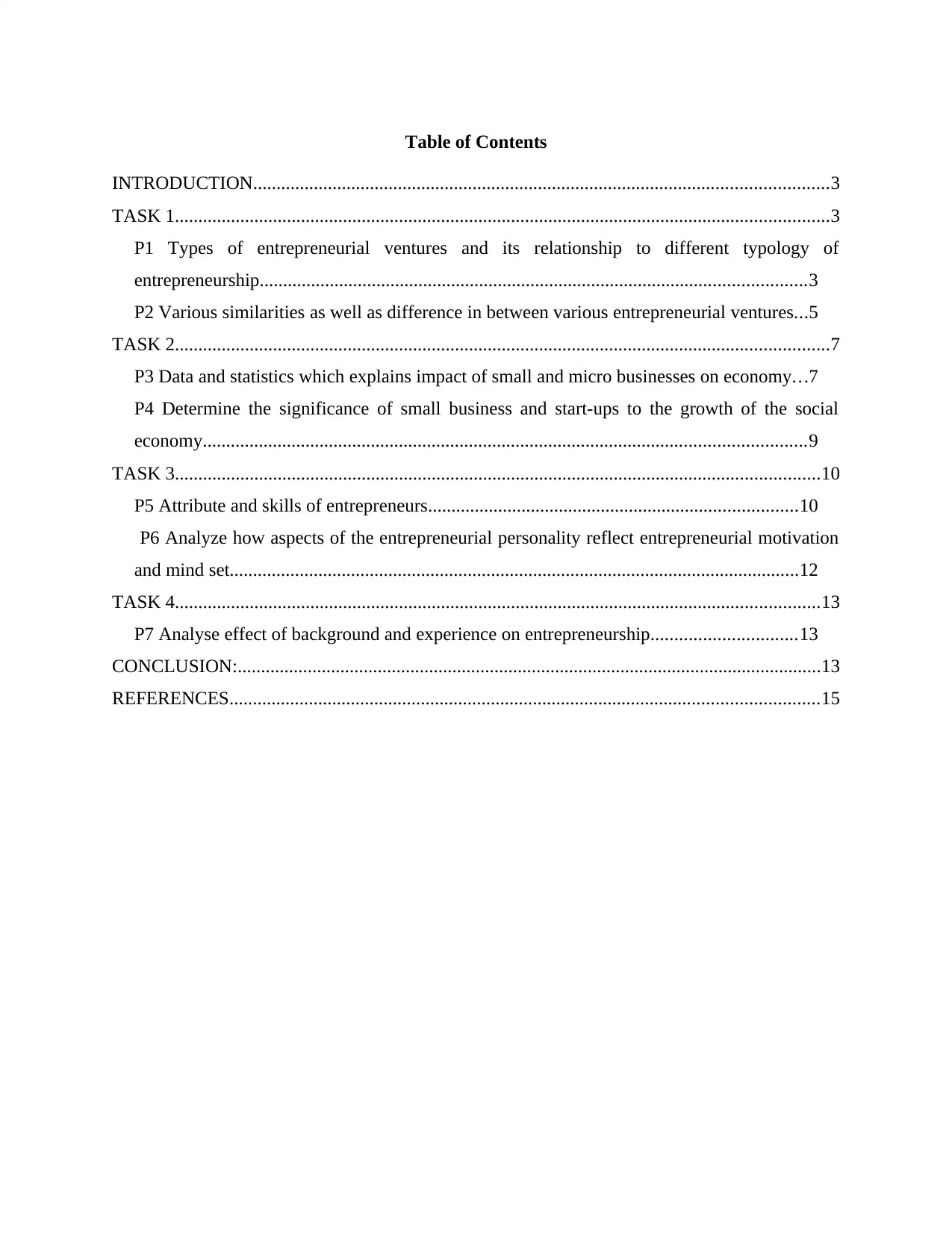
Table of Contents
INTRODUCTION...........................................................................................................................3
TASK 1............................................................................................................................................3
P1 Types of entrepreneurial ventures and its relationship to different typology of
entrepreneurship.....................................................................................................................3
P2 Various similarities as well as difference in between various entrepreneurial ventures...5
TASK 2............................................................................................................................................7
P3 Data and statistics which explains impact of small and micro businesses on economy...7
P4 Determine the significance of small business and start-ups to the growth of the social
economy.................................................................................................................................9
TASK 3..........................................................................................................................................10
P5 Attribute and skills of entrepreneurs...............................................................................10
P6 Analyze how aspects of the entrepreneurial personality reflect entrepreneurial motivation
and mind set..........................................................................................................................12
TASK 4..........................................................................................................................................13
P7 Analyse effect of background and experience on entrepreneurship...............................13
CONCLUSION:.............................................................................................................................13
REFERENCES..............................................................................................................................15
INTRODUCTION...........................................................................................................................3
TASK 1............................................................................................................................................3
P1 Types of entrepreneurial ventures and its relationship to different typology of
entrepreneurship.....................................................................................................................3
P2 Various similarities as well as difference in between various entrepreneurial ventures...5
TASK 2............................................................................................................................................7
P3 Data and statistics which explains impact of small and micro businesses on economy...7
P4 Determine the significance of small business and start-ups to the growth of the social
economy.................................................................................................................................9
TASK 3..........................................................................................................................................10
P5 Attribute and skills of entrepreneurs...............................................................................10
P6 Analyze how aspects of the entrepreneurial personality reflect entrepreneurial motivation
and mind set..........................................................................................................................12
TASK 4..........................................................................................................................................13
P7 Analyse effect of background and experience on entrepreneurship...............................13
CONCLUSION:.............................................................................................................................13
REFERENCES..............................................................................................................................15
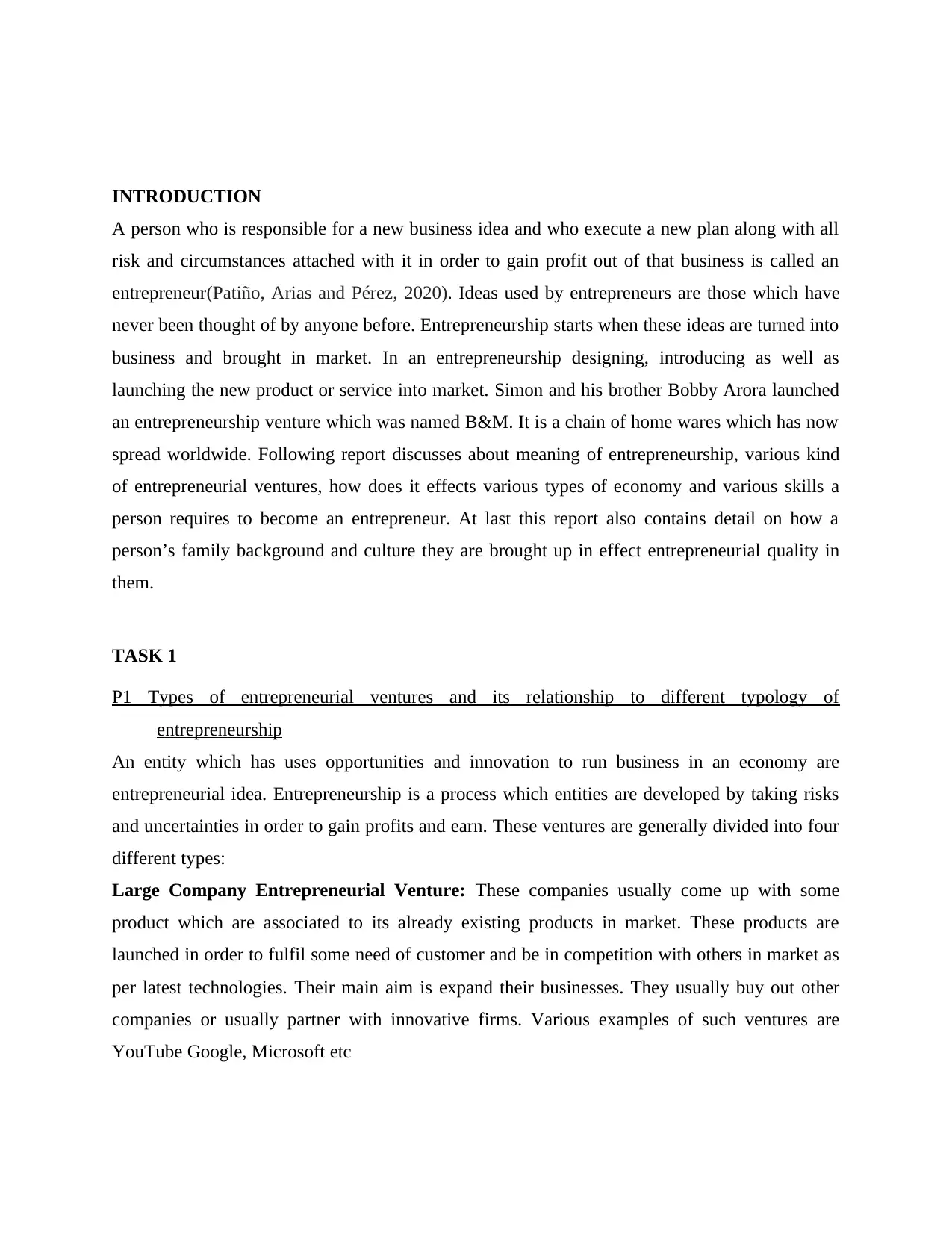
INTRODUCTION
A person who is responsible for a new business idea and who execute a new plan along with all
risk and circumstances attached with it in order to gain profit out of that business is called an
entrepreneur(Patiño, Arias and Pérez, 2020). Ideas used by entrepreneurs are those which have
never been thought of by anyone before. Entrepreneurship starts when these ideas are turned into
business and brought in market. In an entrepreneurship designing, introducing as well as
launching the new product or service into market. Simon and his brother Bobby Arora launched
an entrepreneurship venture which was named B&M. It is a chain of home wares which has now
spread worldwide. Following report discusses about meaning of entrepreneurship, various kind
of entrepreneurial ventures, how does it effects various types of economy and various skills a
person requires to become an entrepreneur. At last this report also contains detail on how a
person’s family background and culture they are brought up in effect entrepreneurial quality in
them.
TASK 1
P1 Types of entrepreneurial ventures and its relationship to different typology of
entrepreneurship
An entity which has uses opportunities and innovation to run business in an economy are
entrepreneurial idea. Entrepreneurship is a process which entities are developed by taking risks
and uncertainties in order to gain profits and earn. These ventures are generally divided into four
different types:
Large Company Entrepreneurial Venture: These companies usually come up with some
product which are associated to its already existing products in market. These products are
launched in order to fulfil some need of customer and be in competition with others in market as
per latest technologies. Their main aim is expand their businesses. They usually buy out other
companies or usually partner with innovative firms. Various examples of such ventures are
YouTube Google, Microsoft etc
A person who is responsible for a new business idea and who execute a new plan along with all
risk and circumstances attached with it in order to gain profit out of that business is called an
entrepreneur(Patiño, Arias and Pérez, 2020). Ideas used by entrepreneurs are those which have
never been thought of by anyone before. Entrepreneurship starts when these ideas are turned into
business and brought in market. In an entrepreneurship designing, introducing as well as
launching the new product or service into market. Simon and his brother Bobby Arora launched
an entrepreneurship venture which was named B&M. It is a chain of home wares which has now
spread worldwide. Following report discusses about meaning of entrepreneurship, various kind
of entrepreneurial ventures, how does it effects various types of economy and various skills a
person requires to become an entrepreneur. At last this report also contains detail on how a
person’s family background and culture they are brought up in effect entrepreneurial quality in
them.
TASK 1
P1 Types of entrepreneurial ventures and its relationship to different typology of
entrepreneurship
An entity which has uses opportunities and innovation to run business in an economy are
entrepreneurial idea. Entrepreneurship is a process which entities are developed by taking risks
and uncertainties in order to gain profits and earn. These ventures are generally divided into four
different types:
Large Company Entrepreneurial Venture: These companies usually come up with some
product which are associated to its already existing products in market. These products are
launched in order to fulfil some need of customer and be in competition with others in market as
per latest technologies. Their main aim is expand their businesses. They usually buy out other
companies or usually partner with innovative firms. Various examples of such ventures are
YouTube Google, Microsoft etc
⊘ This is a preview!⊘
Do you want full access?
Subscribe today to unlock all pages.

Trusted by 1+ million students worldwide

Scalable Entrepreneurial Venture: Scalable entrepreneurs are the ones who bring
innovative ideas in order to being a change in world. Their vision is much larger than other
entrepreneurs in the market. Scalable entrepreneurs are those who bring an idea to change the
world. They have a vision in which they are recruiting various skilled human resources. They
also search for suitable business models usually scalable enough to gain profits. Many examples
of such ventures can be Instagram, Fcaebook, various online shopping applications and many
more.
Small business Entrepreneurial Venture: These days a number of small businesses can
be seen running in marketplaces. In US almost 90% of businesses are small ventures which hire
a number of employees who are non-governmental (Mitra, 2019). Profit earning which they
focus on is only to fulfil their day to day needs. Capitalist are not interests in these small
businesses as they do not require much funds. They usually take help from their friends and
family to start business. Examples of such businesses can be carpenters, plumbers, consultants
etc. who start their business from their home itself.
Social Entrepreneurial Venture: These ventures develop product and services in order to solve
issues in market. They focus on making world a better place to live. They are also non- profit
organisation, profitable organisation or a hybrid of both of them. For example, SafePoint Trust
could be analysed. They are focusing on launching syringes which are reusable. They have tied
up with various small hospitals and clinics who treat patients who can’t afford expensive
treatments. Till now they have produced more than 4 billion such syringes and spread across in
41 countries in world.
All these are different ventures of entrepreneurship which are important in establishing
typologies of business. These typologies have a great effect on ways which business run and
decisions are taken by entrepreneurs. Some of these typologies are mentioned below:
Various typologies of entrepreneurs ventures-
Typology is when things are differentiated on the basis of their types. Basis on which
these styles are differentiated are plan, form, structure, style etc. Some of these typologies are as
followed:
innovative ideas in order to being a change in world. Their vision is much larger than other
entrepreneurs in the market. Scalable entrepreneurs are those who bring an idea to change the
world. They have a vision in which they are recruiting various skilled human resources. They
also search for suitable business models usually scalable enough to gain profits. Many examples
of such ventures can be Instagram, Fcaebook, various online shopping applications and many
more.
Small business Entrepreneurial Venture: These days a number of small businesses can
be seen running in marketplaces. In US almost 90% of businesses are small ventures which hire
a number of employees who are non-governmental (Mitra, 2019). Profit earning which they
focus on is only to fulfil their day to day needs. Capitalist are not interests in these small
businesses as they do not require much funds. They usually take help from their friends and
family to start business. Examples of such businesses can be carpenters, plumbers, consultants
etc. who start their business from their home itself.
Social Entrepreneurial Venture: These ventures develop product and services in order to solve
issues in market. They focus on making world a better place to live. They are also non- profit
organisation, profitable organisation or a hybrid of both of them. For example, SafePoint Trust
could be analysed. They are focusing on launching syringes which are reusable. They have tied
up with various small hospitals and clinics who treat patients who can’t afford expensive
treatments. Till now they have produced more than 4 billion such syringes and spread across in
41 countries in world.
All these are different ventures of entrepreneurship which are important in establishing
typologies of business. These typologies have a great effect on ways which business run and
decisions are taken by entrepreneurs. Some of these typologies are mentioned below:
Various typologies of entrepreneurs ventures-
Typology is when things are differentiated on the basis of their types. Basis on which
these styles are differentiated are plan, form, structure, style etc. Some of these typologies are as
followed:
Paraphrase This Document
Need a fresh take? Get an instant paraphrase of this document with our AI Paraphraser

Aggressive growth Ventures: They are those who use more advanced technology and
are more innovative then others. Their aim is to stay in market for longer period of time and
focus on growth. They usually focus on expanding their business globally. Large scale
enterprises are focusing on aggressive growth in marketplace.
Lifestyle Ventures: These are ventures who do not aim for expansion or growth but they
usually aim at providing satisfaction to its consumers. These ventures only have a limited
number of human resource. They run their business in a single place. A business organisation
which is working in single place can be said to be a lifestyle venture.
Managed growth Ventures: These organisations focus expanding their operations and
spreading their work throughout the world. Their aim is to generate higher profits and earn as
much as they can (Jazid, Ibrahim and Rashid 2019). They have a good management and they
look for skilled workers who will provide them good quality of products and services. Scalable
businesses are perfect example for managed growth.
Survival Ventures: they are ventures who focus on helping people with their basic
needs. They usually initiate businesses in order to higher the standard of living of people in
society. They help enhancing social status of people in society. Micro businesses are examples of
micro businesses.
P2 Various similarities as well as difference in between various entrepreneurial ventures
Similarities Social enterprise Scalable
entrepreneurial
ventures
Large company
entrepreneurial
ventures
1 They usually focus on
just fulfilling needs of
people who are
surviving tin society.
They deeply study
requirements of
people and then
innovate such
products which will
fulfil their needs and
requirements.
They also fulfil needs
and wants of customer
but they generally
operate in a very large
scale.
are more innovative then others. Their aim is to stay in market for longer period of time and
focus on growth. They usually focus on expanding their business globally. Large scale
enterprises are focusing on aggressive growth in marketplace.
Lifestyle Ventures: These are ventures who do not aim for expansion or growth but they
usually aim at providing satisfaction to its consumers. These ventures only have a limited
number of human resource. They run their business in a single place. A business organisation
which is working in single place can be said to be a lifestyle venture.
Managed growth Ventures: These organisations focus expanding their operations and
spreading their work throughout the world. Their aim is to generate higher profits and earn as
much as they can (Jazid, Ibrahim and Rashid 2019). They have a good management and they
look for skilled workers who will provide them good quality of products and services. Scalable
businesses are perfect example for managed growth.
Survival Ventures: they are ventures who focus on helping people with their basic
needs. They usually initiate businesses in order to higher the standard of living of people in
society. They help enhancing social status of people in society. Micro businesses are examples of
micro businesses.
P2 Various similarities as well as difference in between various entrepreneurial ventures
Similarities Social enterprise Scalable
entrepreneurial
ventures
Large company
entrepreneurial
ventures
1 They usually focus on
just fulfilling needs of
people who are
surviving tin society.
They deeply study
requirements of
people and then
innovate such
products which will
fulfil their needs and
requirements.
They also fulfil needs
and wants of customer
but they generally
operate in a very large
scale.
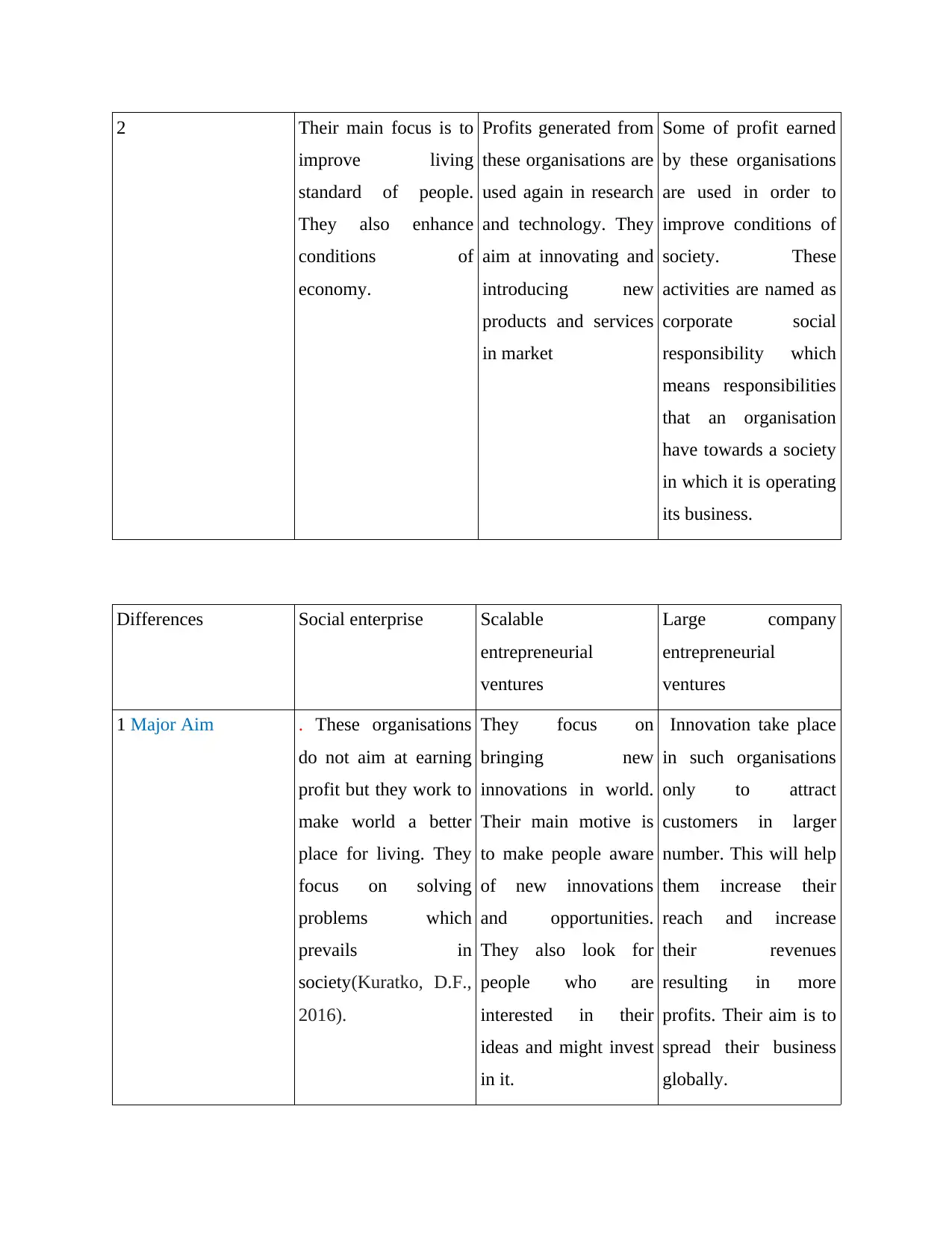
2 Their main focus is to
improve living
standard of people.
They also enhance
conditions of
economy.
Profits generated from
these organisations are
used again in research
and technology. They
aim at innovating and
introducing new
products and services
in market
Some of profit earned
by these organisations
are used in order to
improve conditions of
society. These
activities are named as
corporate social
responsibility which
means responsibilities
that an organisation
have towards a society
in which it is operating
its business.
Differences Social enterprise Scalable
entrepreneurial
ventures
Large company
entrepreneurial
ventures
1 Major Aim . These organisations
do not aim at earning
profit but they work to
make world a better
place for living. They
focus on solving
problems which
prevails in
society(Kuratko, D.F.,
2016).
They focus on
bringing new
innovations in world.
Their main motive is
to make people aware
of new innovations
and opportunities.
They also look for
people who are
interested in their
ideas and might invest
in it.
Innovation take place
in such organisations
only to attract
customers in larger
number. This will help
them increase their
reach and increase
their revenues
resulting in more
profits. Their aim is to
spread their business
globally.
improve living
standard of people.
They also enhance
conditions of
economy.
Profits generated from
these organisations are
used again in research
and technology. They
aim at innovating and
introducing new
products and services
in market
Some of profit earned
by these organisations
are used in order to
improve conditions of
society. These
activities are named as
corporate social
responsibility which
means responsibilities
that an organisation
have towards a society
in which it is operating
its business.
Differences Social enterprise Scalable
entrepreneurial
ventures
Large company
entrepreneurial
ventures
1 Major Aim . These organisations
do not aim at earning
profit but they work to
make world a better
place for living. They
focus on solving
problems which
prevails in
society(Kuratko, D.F.,
2016).
They focus on
bringing new
innovations in world.
Their main motive is
to make people aware
of new innovations
and opportunities.
They also look for
people who are
interested in their
ideas and might invest
in it.
Innovation take place
in such organisations
only to attract
customers in larger
number. This will help
them increase their
reach and increase
their revenues
resulting in more
profits. Their aim is to
spread their business
globally.
⊘ This is a preview!⊘
Do you want full access?
Subscribe today to unlock all pages.

Trusted by 1+ million students worldwide
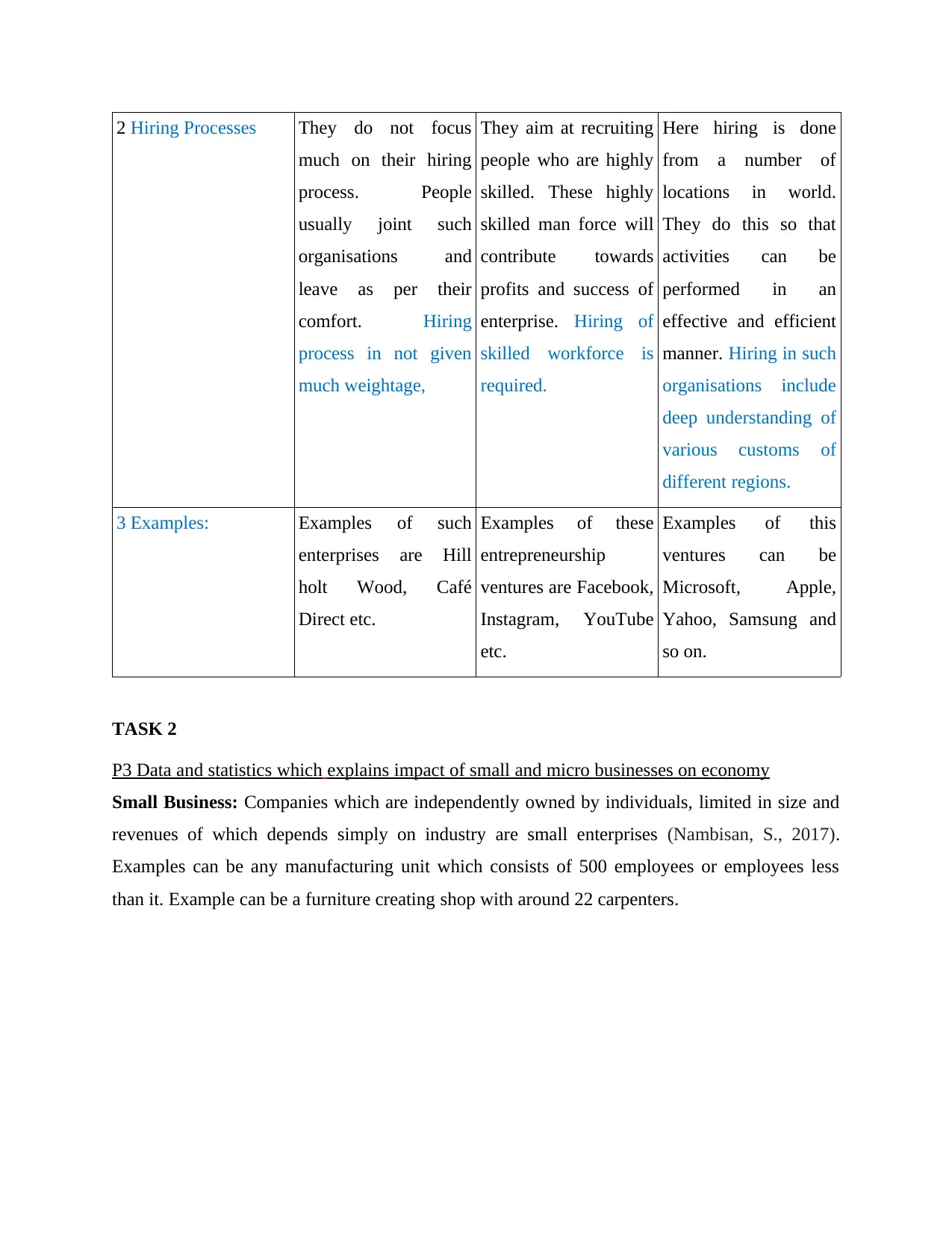
2 Hiring Processes They do not focus
much on their hiring
process. People
usually joint such
organisations and
leave as per their
comfort. Hiring
process in not given
much weightage,
They aim at recruiting
people who are highly
skilled. These highly
skilled man force will
contribute towards
profits and success of
enterprise. Hiring of
skilled workforce is
required.
Here hiring is done
from a number of
locations in world.
They do this so that
activities can be
performed in an
effective and efficient
manner. Hiring in such
organisations include
deep understanding of
various customs of
different regions.
3 Examples: Examples of such
enterprises are Hill
holt Wood, Café
Direct etc.
Examples of these
entrepreneurship
ventures are Facebook,
Instagram, YouTube
etc.
Examples of this
ventures can be
Microsoft, Apple,
Yahoo, Samsung and
so on.
TASK 2
P3 Data and statistics which explains impact of small and micro businesses on economy
Small Business: Companies which are independently owned by individuals, limited in size and
revenues of which depends simply on industry are small enterprises (Nambisan, S., 2017).
Examples can be any manufacturing unit which consists of 500 employees or employees less
than it. Example can be a furniture creating shop with around 22 carpenters.
much on their hiring
process. People
usually joint such
organisations and
leave as per their
comfort. Hiring
process in not given
much weightage,
They aim at recruiting
people who are highly
skilled. These highly
skilled man force will
contribute towards
profits and success of
enterprise. Hiring of
skilled workforce is
required.
Here hiring is done
from a number of
locations in world.
They do this so that
activities can be
performed in an
effective and efficient
manner. Hiring in such
organisations include
deep understanding of
various customs of
different regions.
3 Examples: Examples of such
enterprises are Hill
holt Wood, Café
Direct etc.
Examples of these
entrepreneurship
ventures are Facebook,
Instagram, YouTube
etc.
Examples of this
ventures can be
Microsoft, Apple,
Yahoo, Samsung and
so on.
TASK 2
P3 Data and statistics which explains impact of small and micro businesses on economy
Small Business: Companies which are independently owned by individuals, limited in size and
revenues of which depends simply on industry are small enterprises (Nambisan, S., 2017).
Examples can be any manufacturing unit which consists of 500 employees or employees less
than it. Example can be a furniture creating shop with around 22 carpenters.
Paraphrase This Document
Need a fresh take? Get an instant paraphrase of this document with our AI Paraphraser
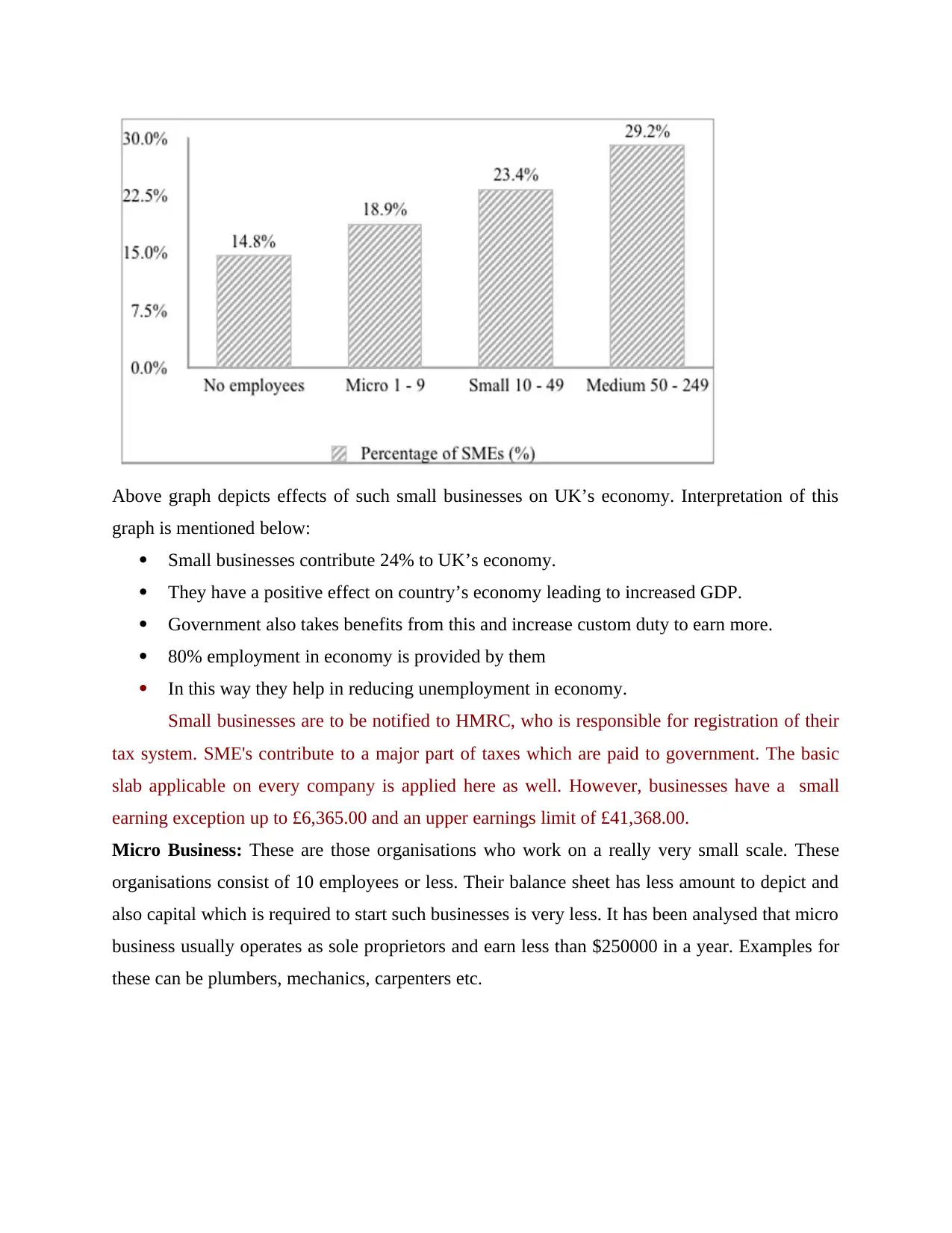
Above graph depicts effects of such small businesses on UK’s economy. Interpretation of this
graph is mentioned below:
Small businesses contribute 24% to UK’s economy.
They have a positive effect on country’s economy leading to increased GDP.
Government also takes benefits from this and increase custom duty to earn more.
80% employment in economy is provided by them
In this way they help in reducing unemployment in economy.
Small businesses are to be notified to HMRC, who is responsible for registration of their
tax system. SME's contribute to a major part of taxes which are paid to government. The basic
slab applicable on every company is applied here as well. However, businesses have a small
earning exception up to £6,365.00 and an upper earnings limit of £41,368.00.
Micro Business: These are those organisations who work on a really very small scale. These
organisations consist of 10 employees or less. Their balance sheet has less amount to depict and
also capital which is required to start such businesses is very less. It has been analysed that micro
business usually operates as sole proprietors and earn less than $250000 in a year. Examples for
these can be plumbers, mechanics, carpenters etc.
graph is mentioned below:
Small businesses contribute 24% to UK’s economy.
They have a positive effect on country’s economy leading to increased GDP.
Government also takes benefits from this and increase custom duty to earn more.
80% employment in economy is provided by them
In this way they help in reducing unemployment in economy.
Small businesses are to be notified to HMRC, who is responsible for registration of their
tax system. SME's contribute to a major part of taxes which are paid to government. The basic
slab applicable on every company is applied here as well. However, businesses have a small
earning exception up to £6,365.00 and an upper earnings limit of £41,368.00.
Micro Business: These are those organisations who work on a really very small scale. These
organisations consist of 10 employees or less. Their balance sheet has less amount to depict and
also capital which is required to start such businesses is very less. It has been analysed that micro
business usually operates as sole proprietors and earn less than $250000 in a year. Examples for
these can be plumbers, mechanics, carpenters etc.
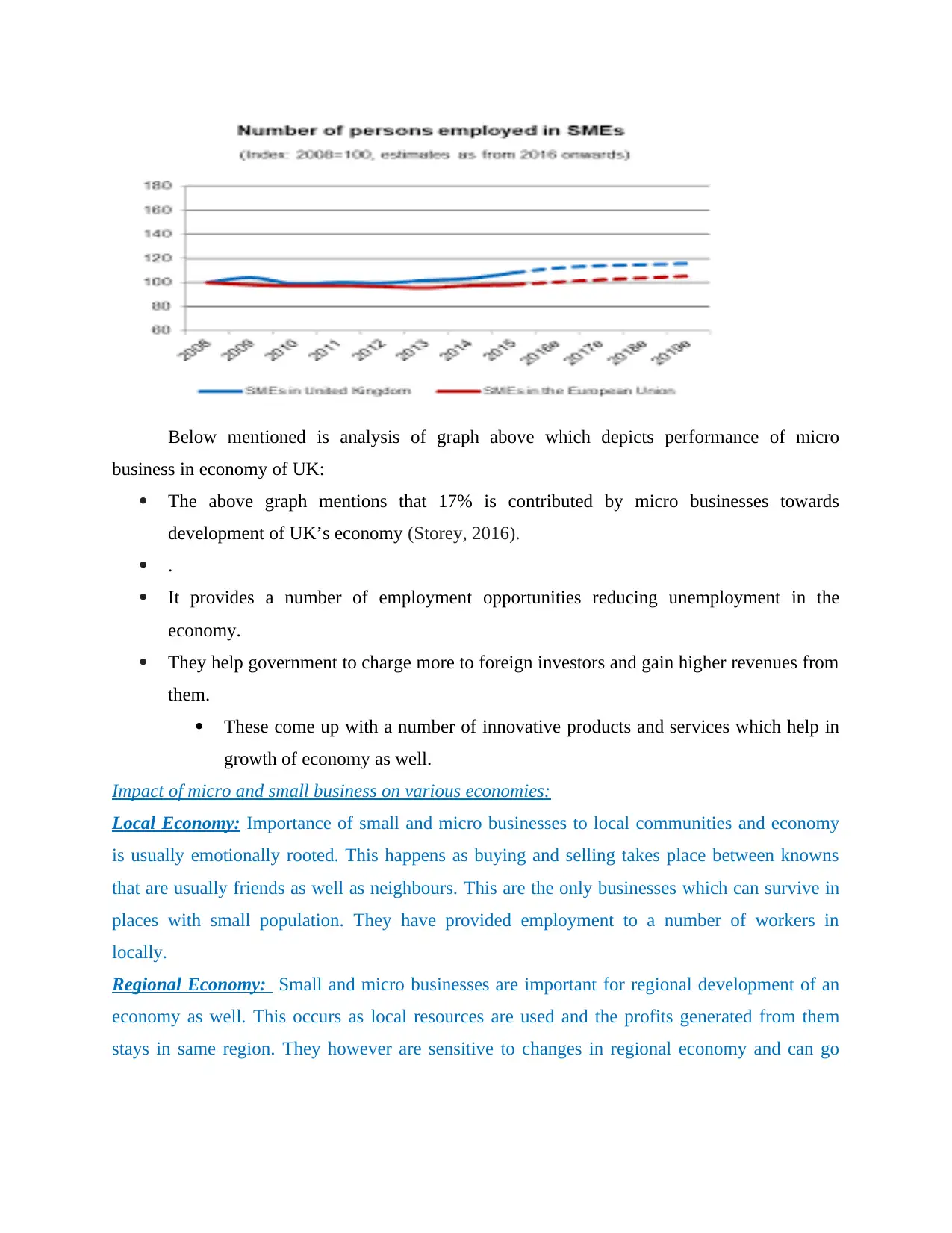
Below mentioned is analysis of graph above which depicts performance of micro
business in economy of UK:
The above graph mentions that 17% is contributed by micro businesses towards
development of UK’s economy (Storey, 2016).
.
It provides a number of employment opportunities reducing unemployment in the
economy.
They help government to charge more to foreign investors and gain higher revenues from
them.
These come up with a number of innovative products and services which help in
growth of economy as well.
Impact of micro and small business on various economies:
Local Economy: Importance of small and micro businesses to local communities and economy
is usually emotionally rooted. This happens as buying and selling takes place between knowns
that are usually friends as well as neighbours. This are the only businesses which can survive in
places with small population. They have provided employment to a number of workers in
locally.
Regional Economy: Small and micro businesses are important for regional development of an
economy as well. This occurs as local resources are used and the profits generated from them
stays in same region. They however are sensitive to changes in regional economy and can go
business in economy of UK:
The above graph mentions that 17% is contributed by micro businesses towards
development of UK’s economy (Storey, 2016).
.
It provides a number of employment opportunities reducing unemployment in the
economy.
They help government to charge more to foreign investors and gain higher revenues from
them.
These come up with a number of innovative products and services which help in
growth of economy as well.
Impact of micro and small business on various economies:
Local Economy: Importance of small and micro businesses to local communities and economy
is usually emotionally rooted. This happens as buying and selling takes place between knowns
that are usually friends as well as neighbours. This are the only businesses which can survive in
places with small population. They have provided employment to a number of workers in
locally.
Regional Economy: Small and micro businesses are important for regional development of an
economy as well. This occurs as local resources are used and the profits generated from them
stays in same region. They however are sensitive to changes in regional economy and can go
⊘ This is a preview!⊘
Do you want full access?
Subscribe today to unlock all pages.

Trusted by 1+ million students worldwide
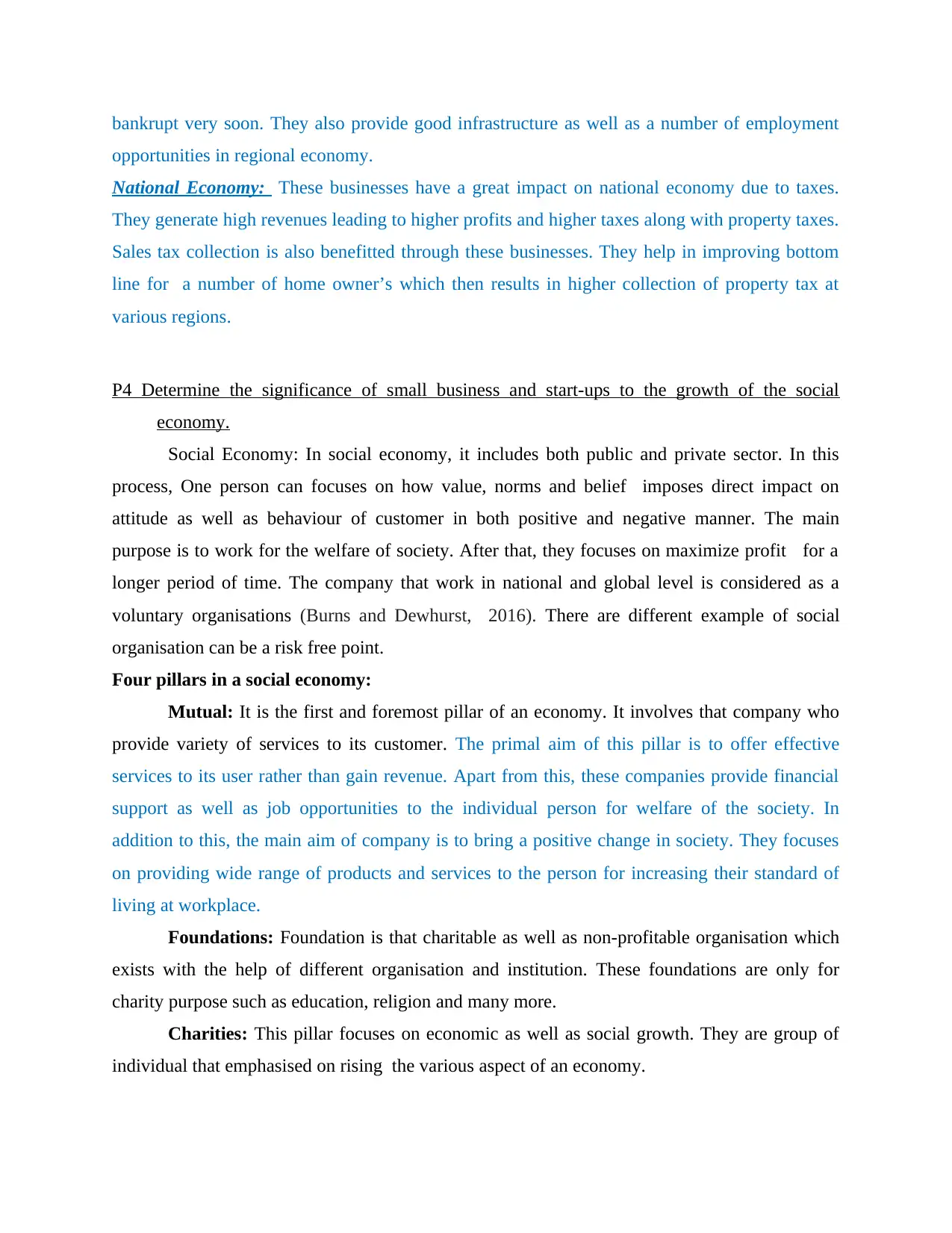
bankrupt very soon. They also provide good infrastructure as well as a number of employment
opportunities in regional economy.
National Economy: These businesses have a great impact on national economy due to taxes.
They generate high revenues leading to higher profits and higher taxes along with property taxes.
Sales tax collection is also benefitted through these businesses. They help in improving bottom
line for a number of home owner’s which then results in higher collection of property tax at
various regions.
P4 Determine the significance of small business and start-ups to the growth of the social
economy.
Social Economy: In social economy, it includes both public and private sector. In this
process, One person can focuses on how value, norms and belief imposes direct impact on
attitude as well as behaviour of customer in both positive and negative manner. The main
purpose is to work for the welfare of society. After that, they focuses on maximize profit for a
longer period of time. The company that work in national and global level is considered as a
voluntary organisations (Burns and Dewhurst, 2016). There are different example of social
organisation can be a risk free point.
Four pillars in a social economy:
Mutual: It is the first and foremost pillar of an economy. It involves that company who
provide variety of services to its customer. The primal aim of this pillar is to offer effective
services to its user rather than gain revenue. Apart from this, these companies provide financial
support as well as job opportunities to the individual person for welfare of the society. In
addition to this, the main aim of company is to bring a positive change in society. They focuses
on providing wide range of products and services to the person for increasing their standard of
living at workplace.
Foundations: Foundation is that charitable as well as non-profitable organisation which
exists with the help of different organisation and institution. These foundations are only for
charity purpose such as education, religion and many more.
Charities: This pillar focuses on economic as well as social growth. They are group of
individual that emphasised on rising the various aspect of an economy.
opportunities in regional economy.
National Economy: These businesses have a great impact on national economy due to taxes.
They generate high revenues leading to higher profits and higher taxes along with property taxes.
Sales tax collection is also benefitted through these businesses. They help in improving bottom
line for a number of home owner’s which then results in higher collection of property tax at
various regions.
P4 Determine the significance of small business and start-ups to the growth of the social
economy.
Social Economy: In social economy, it includes both public and private sector. In this
process, One person can focuses on how value, norms and belief imposes direct impact on
attitude as well as behaviour of customer in both positive and negative manner. The main
purpose is to work for the welfare of society. After that, they focuses on maximize profit for a
longer period of time. The company that work in national and global level is considered as a
voluntary organisations (Burns and Dewhurst, 2016). There are different example of social
organisation can be a risk free point.
Four pillars in a social economy:
Mutual: It is the first and foremost pillar of an economy. It involves that company who
provide variety of services to its customer. The primal aim of this pillar is to offer effective
services to its user rather than gain revenue. Apart from this, these companies provide financial
support as well as job opportunities to the individual person for welfare of the society. In
addition to this, the main aim of company is to bring a positive change in society. They focuses
on providing wide range of products and services to the person for increasing their standard of
living at workplace.
Foundations: Foundation is that charitable as well as non-profitable organisation which
exists with the help of different organisation and institution. These foundations are only for
charity purpose such as education, religion and many more.
Charities: This pillar focuses on economic as well as social growth. They are group of
individual that emphasised on rising the various aspect of an economy.
Paraphrase This Document
Need a fresh take? Get an instant paraphrase of this document with our AI Paraphraser
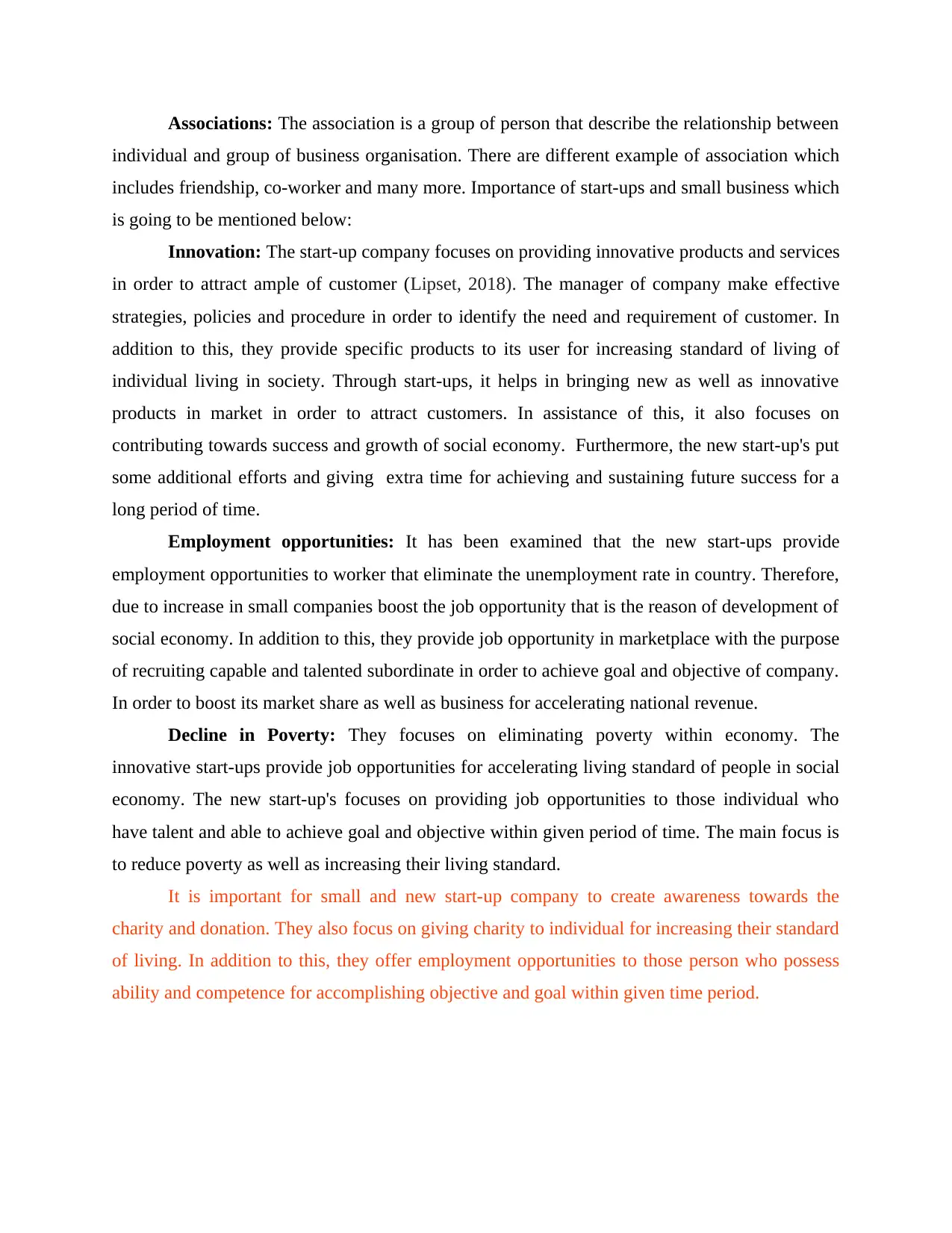
Associations: The association is a group of person that describe the relationship between
individual and group of business organisation. There are different example of association which
includes friendship, co-worker and many more. Importance of start-ups and small business which
is going to be mentioned below:
Innovation: The start-up company focuses on providing innovative products and services
in order to attract ample of customer (Lipset, 2018). The manager of company make effective
strategies, policies and procedure in order to identify the need and requirement of customer. In
addition to this, they provide specific products to its user for increasing standard of living of
individual living in society. Through start-ups, it helps in bringing new as well as innovative
products in market in order to attract customers. In assistance of this, it also focuses on
contributing towards success and growth of social economy. Furthermore, the new start-up's put
some additional efforts and giving extra time for achieving and sustaining future success for a
long period of time.
Employment opportunities: It has been examined that the new start-ups provide
employment opportunities to worker that eliminate the unemployment rate in country. Therefore,
due to increase in small companies boost the job opportunity that is the reason of development of
social economy. In addition to this, they provide job opportunity in marketplace with the purpose
of recruiting capable and talented subordinate in order to achieve goal and objective of company.
In order to boost its market share as well as business for accelerating national revenue.
Decline in Poverty: They focuses on eliminating poverty within economy. The
innovative start-ups provide job opportunities for accelerating living standard of people in social
economy. The new start-up's focuses on providing job opportunities to those individual who
have talent and able to achieve goal and objective within given period of time. The main focus is
to reduce poverty as well as increasing their living standard.
It is important for small and new start-up company to create awareness towards the
charity and donation. They also focus on giving charity to individual for increasing their standard
of living. In addition to this, they offer employment opportunities to those person who possess
ability and competence for accomplishing objective and goal within given time period.
individual and group of business organisation. There are different example of association which
includes friendship, co-worker and many more. Importance of start-ups and small business which
is going to be mentioned below:
Innovation: The start-up company focuses on providing innovative products and services
in order to attract ample of customer (Lipset, 2018). The manager of company make effective
strategies, policies and procedure in order to identify the need and requirement of customer. In
addition to this, they provide specific products to its user for increasing standard of living of
individual living in society. Through start-ups, it helps in bringing new as well as innovative
products in market in order to attract customers. In assistance of this, it also focuses on
contributing towards success and growth of social economy. Furthermore, the new start-up's put
some additional efforts and giving extra time for achieving and sustaining future success for a
long period of time.
Employment opportunities: It has been examined that the new start-ups provide
employment opportunities to worker that eliminate the unemployment rate in country. Therefore,
due to increase in small companies boost the job opportunity that is the reason of development of
social economy. In addition to this, they provide job opportunity in marketplace with the purpose
of recruiting capable and talented subordinate in order to achieve goal and objective of company.
In order to boost its market share as well as business for accelerating national revenue.
Decline in Poverty: They focuses on eliminating poverty within economy. The
innovative start-ups provide job opportunities for accelerating living standard of people in social
economy. The new start-up's focuses on providing job opportunities to those individual who
have talent and able to achieve goal and objective within given period of time. The main focus is
to reduce poverty as well as increasing their living standard.
It is important for small and new start-up company to create awareness towards the
charity and donation. They also focus on giving charity to individual for increasing their standard
of living. In addition to this, they offer employment opportunities to those person who possess
ability and competence for accomplishing objective and goal within given time period.
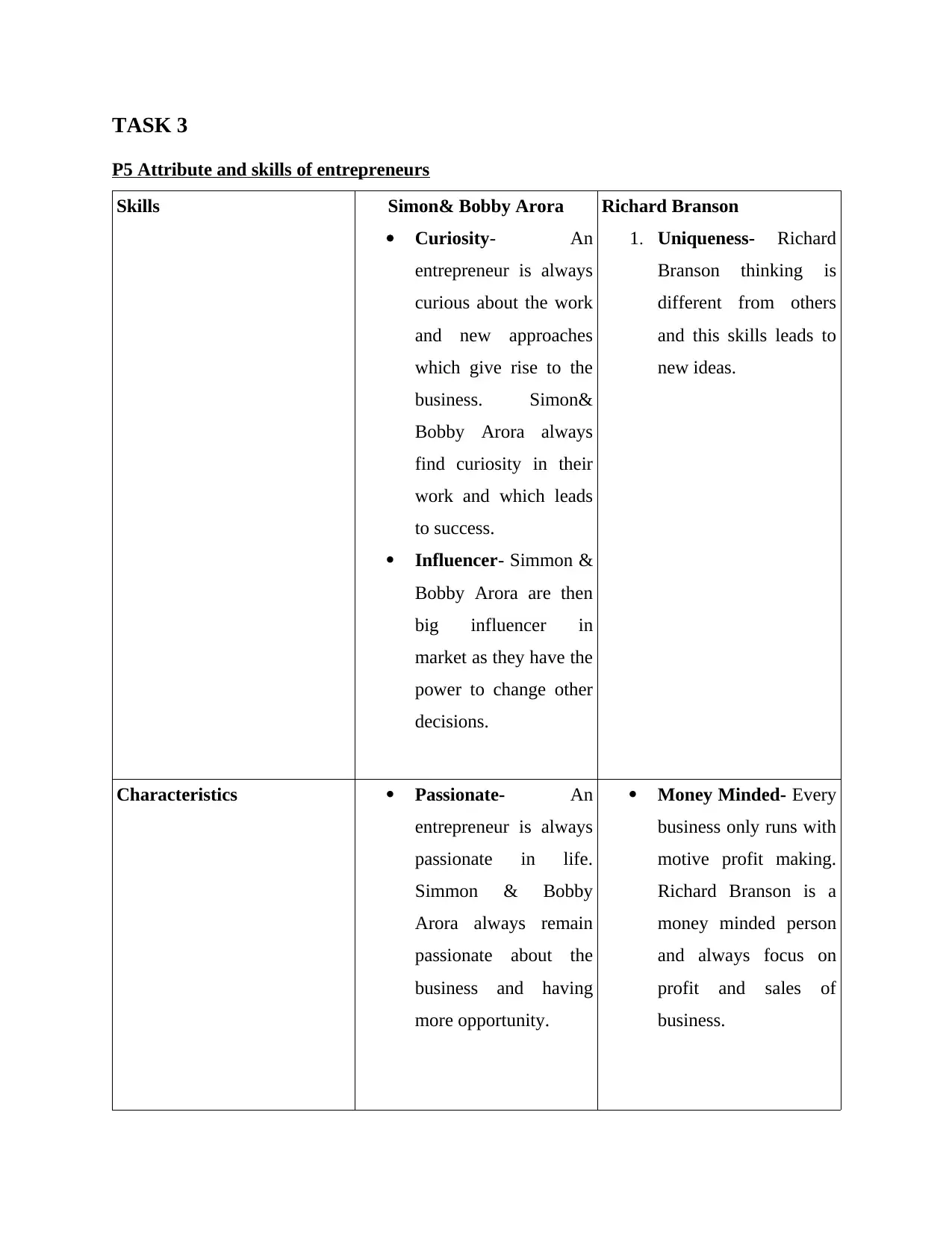
TASK 3
P5 Attribute and skills of entrepreneurs
Skills Simon& Bobby Arora
Curiosity- An
entrepreneur is always
curious about the work
and new approaches
which give rise to the
business. Simon&
Bobby Arora always
find curiosity in their
work and which leads
to success.
Influencer- Simmon &
Bobby Arora are then
big influencer in
market as they have the
power to change other
decisions.
Richard Branson
1. Uniqueness- Richard
Branson thinking is
different from others
and this skills leads to
new ideas.
Characteristics Passionate- An
entrepreneur is always
passionate in life.
Simmon & Bobby
Arora always remain
passionate about the
business and having
more opportunity.
Money Minded- Every
business only runs with
motive profit making.
Richard Branson is a
money minded person
and always focus on
profit and sales of
business.
P5 Attribute and skills of entrepreneurs
Skills Simon& Bobby Arora
Curiosity- An
entrepreneur is always
curious about the work
and new approaches
which give rise to the
business. Simon&
Bobby Arora always
find curiosity in their
work and which leads
to success.
Influencer- Simmon &
Bobby Arora are then
big influencer in
market as they have the
power to change other
decisions.
Richard Branson
1. Uniqueness- Richard
Branson thinking is
different from others
and this skills leads to
new ideas.
Characteristics Passionate- An
entrepreneur is always
passionate in life.
Simmon & Bobby
Arora always remain
passionate about the
business and having
more opportunity.
Money Minded- Every
business only runs with
motive profit making.
Richard Branson is a
money minded person
and always focus on
profit and sales of
business.
⊘ This is a preview!⊘
Do you want full access?
Subscribe today to unlock all pages.

Trusted by 1+ million students worldwide
1 out of 19
Related Documents
Your All-in-One AI-Powered Toolkit for Academic Success.
+13062052269
info@desklib.com
Available 24*7 on WhatsApp / Email
![[object Object]](/_next/static/media/star-bottom.7253800d.svg)
Unlock your academic potential
Copyright © 2020–2025 A2Z Services. All Rights Reserved. Developed and managed by ZUCOL.





